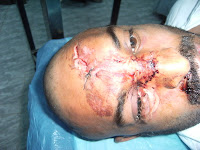
15 November 2008
endoscopic dacrocystorhinostomy
Step 1 :
makeing a circular incision with the sickle knife through the lateral nasal wall mucosa down to bone 1 to 1.5 cm anterior to the base of the uncinate process. This mucosa is then elevated with the Freer elevator and removed.
The underlying bone is carefully penetrated with a curette or drill.
The identification of the lacrimal sac within the lateral nasal wall is facilitated by placement of the Endoillurninator via the lacrimal canaliculus into the sac.
The removed mucous membrane and bone can be guided by the illumination of the sac, and extends posterior to approximate the ethmoid infundibulum or the most anterior of the infundibular cells .



Step 2 :
once the bone is removed, the lacrimal sac is exposed. To confirm this, a lacrimal probe should be inserted through the inferior punctum into the sac. Intranasally the sac will be tented by the probe. A 5- to 10-mm incision in the inferomedial wall of the sac should be made on and exposing the lacrimal probe
Most of the medial wall of the sac should be carefully removed with the Weil-Blakesley forceps.
 Step 3 (Placement of Jones Tube):
Step 3 (Placement of Jones Tube):
The stents are grasped with a Blakesley forceps, withdrawn from the nasal cavity, and cut from the tubing
The silastic stents are either tied to each other or held together by a silk suture. As the stents are intubating the canaliculi, sac, and adjacent nose in one continuous loop, the loop as visualized at the medial canthus can be transected in 3 months to withdraw the tubing through the nose.
A small nasal pack may be necessary for hemostasis
makeing a circular incision with the sickle knife through the lateral nasal wall mucosa down to bone 1 to 1.5 cm anterior to the base of the uncinate process. This mucosa is then elevated with the Freer elevator and removed.
The underlying bone is carefully penetrated with a curette or drill.
The identification of the lacrimal sac within the lateral nasal wall is facilitated by placement of the Endoillurninator via the lacrimal canaliculus into the sac.
The removed mucous membrane and bone can be guided by the illumination of the sac, and extends posterior to approximate the ethmoid infundibulum or the most anterior of the infundibular cells .



Step 2 :
once the bone is removed, the lacrimal sac is exposed. To confirm this, a lacrimal probe should be inserted through the inferior punctum into the sac. Intranasally the sac will be tented by the probe. A 5- to 10-mm incision in the inferomedial wall of the sac should be made on and exposing the lacrimal probe
Most of the medial wall of the sac should be carefully removed with the Weil-Blakesley forceps.
 Step 3 (Placement of Jones Tube):
Step 3 (Placement of Jones Tube):The stents are grasped with a Blakesley forceps, withdrawn from the nasal cavity, and cut from the tubing
The silastic stents are either tied to each other or held together by a silk suture. As the stents are intubating the canaliculi, sac, and adjacent nose in one continuous loop, the loop as visualized at the medial canthus can be transected in 3 months to withdraw the tubing through the nose.
A small nasal pack may be necessary for hemostasis
14 November 2008
endoscopic unilateral (RT) choanal atresia



 The position of the instrument in the nasopharynx is confirmed:
The position of the instrument in the nasopharynx is confirmed:In unilateral cases, the position is confirmed using a 0° or 30° endoscope through the contralateral nasal passage.
Step 1 :
Hemitransfixation incision, Elevation of the mucoperichondium and mucoperiostium

Step 2 :
Removal of the vomer and sphenoid rostum,
A backbiting forceps removes further portions of the vomer and bony septum.

Removal of the vomer and sphenoid rostum,
A backbiting forceps removes further portions of the vomer and bony septum.

Step 3 :
Elevation of the mucosa of the atresial plate
Removal of the plate by Kerrison rongeurs, The forceps is inserted on the atretic side, and appropriate position is confirmed with a 0° endoscope on the contralateral side. This is an important step in gaining an adequate opening for the choanal
Septoplasty also was done
Elevation of the mucosa of the atresial plate
Removal of the plate by Kerrison rongeurs, The forceps is inserted on the atretic side, and appropriate position is confirmed with a 0° endoscope on the contralateral side. This is an important step in gaining an adequate opening for the choanal
Septoplasty also was done



Subscribe to:
Posts (Atom)

































.jpg)
.jpg)




